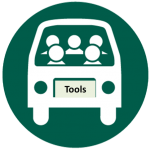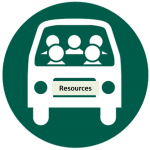 Welcome to Part 3 of my discussion of Process Analysis & Commuting. In Part 1 we introduced the idea of starting your Process Analysis by first looking at the large picture. We then moved on to a discussion of some of the resources that are involved in the commuting process. In this post I want to take a look at some of the tools that can be used in the Process Analysis as we start diving a little deeper into the Analysis. I am still trying to stay at a relatively high level so will not go into great detail but any of these tools can be used at a much deeper level than I will go into during this discussion. Also, just as a reminder, the answer to my original question was – The purpose of the commuting process is to move people and products from one point to another point as effectively as possible using the minimum of resources possible. So, if we are trying to analyse this process we would obviously need to look at the pros and cons of each possible method or resource (as discussed in Part 2). To a large extent this is a customer service type of analysis since the resource supplier (government in most cases) must decide what services they will make available to the customer (commuter) and at what service level. As with any customer service situation, in the end the customer gets to decide what service they wish to “buy”. So what are some of the tools to analyse this process? While not an exhaustive list, here are a couple:
Welcome to Part 3 of my discussion of Process Analysis & Commuting. In Part 1 we introduced the idea of starting your Process Analysis by first looking at the large picture. We then moved on to a discussion of some of the resources that are involved in the commuting process. In this post I want to take a look at some of the tools that can be used in the Process Analysis as we start diving a little deeper into the Analysis. I am still trying to stay at a relatively high level so will not go into great detail but any of these tools can be used at a much deeper level than I will go into during this discussion. Also, just as a reminder, the answer to my original question was – The purpose of the commuting process is to move people and products from one point to another point as effectively as possible using the minimum of resources possible. So, if we are trying to analyse this process we would obviously need to look at the pros and cons of each possible method or resource (as discussed in Part 2). To a large extent this is a customer service type of analysis since the resource supplier (government in most cases) must decide what services they will make available to the customer (commuter) and at what service level. As with any customer service situation, in the end the customer gets to decide what service they wish to “buy”. So what are some of the tools to analyse this process? While not an exhaustive list, here are a couple:
Lean – Actually this is a tool set rather than a specific tool and there are many possibilities inside the set but I wanted to bring your attention to the 8 wastes concept. If we look at each of the resources discussed earlier, which ones generate the most waste and how do these wastes interact? Two of the wastes listed are waiting and unnecessary movement. With this in mind an analysis of the length of time for each method and what makes up the time involved would be a good start. For example, when driving during “rush hour”, the time involved could be 60 minutes but the same drive an hour later may only be 35 minutes and on a Sunday afternoon may only be 15 minutes. Perhaps a staggered start time would spread the resource requirements and speed everything up. Of course that does leave the question of how to co-ordinate that type of program. Some additional questions that this brings up would be: What is the capacity usage of the resource (road), What is the cost of expanded resources, What other ways are there to decrease the resource requirement…? Similarly, we know that in most cases it takes longer to use mass transit then to use your car, but what makes it longer? Most of the time is expended in getting to the mass transit entry process and then waiting for the resource (bus, train, etc). Does the efficiency of moving large numbers of people at a time outweigh the time spent waiting to use the resource? What could be done to shorten this queue time?
Theory of Constraints – The basis of theory of constraints is that one part of any operation will be the bottleneck that sets the speed for the entire process. Only changes to the bottleneck can speed up the process since changes anywhere else will still not allow the process to run any faster than the bottleneck. The trick here is to identify the bottle neck and to make effective changes (which is NOT as easy as it sounds). Let’s take a somewhat simplified example of using the bus – The steps in this process may be: Leave house, walk to bus stop, wait for bus, board bus, ride bus to desired stop, get off bus, walk to work. This is simplified as I am not considering many of the complications such as transfers, etc. So which step is the bottleneck? The longest time is the ride on the bus but that is not necessarily a process bottleneck as there are a string of buses with a new one coming on a schedule (let’s say every 15 min). The bus carries many people at one time so the number of finished units (people) arriving at the end of the operation is actually relatively high. You could make it higher yet by adding more buses to the line (reducing time between buses) or using bigger buses to carry more people per bus. The problem with this is, if there are not enough people at the various stops, what you will have is partially filled buses which would be a waste of the resource. In actual fact the bottleneck in this example is the number of people arriving at the bus stop to catch the next bus and this is a factor of the total number of people using the bus and the time of day. How do you increase the number of people using the bus and flatten the cyclical pattern at the same time? Perhaps, rather than adding more buses to a specific line it would be better to add more routes and split smaller buses across them. Shortening the walk (especially in inclement weather) and the wait time might encourage more ridership which would increase revenue to offset the cost of the increased drivers that would be required.
Continuous Improvement – This one is pretty self-explanatory but is probably best applied to the customer experience. It is a proven fact that people will pay more if they perceive value to a particular product or process. One way this can be used in practise is to remember that people will almost always pick a better experience over a poorer experience. This can be used two ways. Degrade the process you are trying to move people away from and/or improve the process you want people to move to. I strongly suggest using positive reinforcement as negative reinforcement (degrading service) has all kinds of nasty side effects, such as very grumpy voters in an election.
House of Quality – I am actually not going to go into House of Quality in this post though the idea of using this tool to better understand what the customer wants and how to provide it is very intriguing. If anyone else wants to follow up with a Quality series on this topic I would love to see it.
I am going to cut off the tools at this point. As with many of the other thoughts raised in this series we could write books about each of them. Instead, please join me in Part 4 where we can summarize this entire discussion and maybe suggest a couple of possible (partial) solutions.

